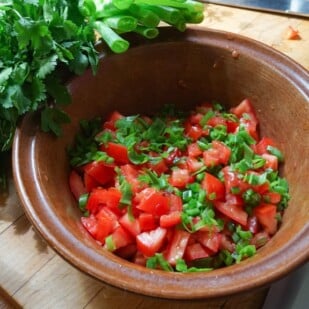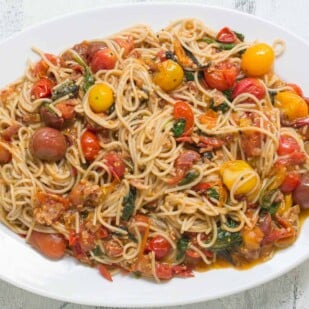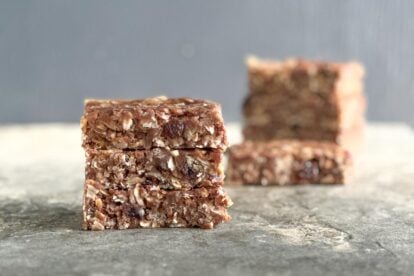What Makes the Best Low FODMAP Burger?
You can have awesome burgers while following the low FODMAP diet. We start with freshly ground beef, preferably about 80% lean to keep it juicy. We love them cooked on the grill outdoors, but a cast iron pan or grill-pan indoors works wonders, too.
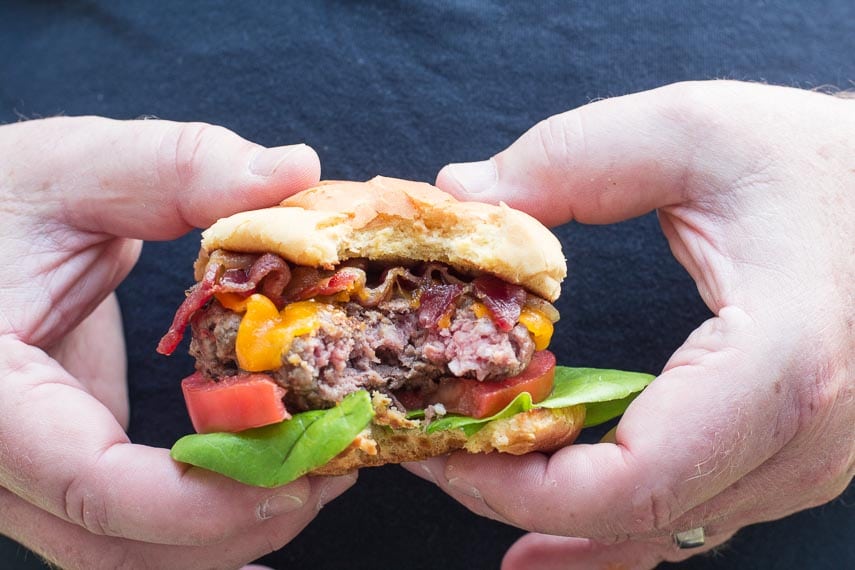
Then we add low FODMAP seasonings and add-ons, like cheese and sometimes more than one condiment. We like a low FODMAP roll, too, although we have also been known to just wrap our burger up in a lettuce leaf.
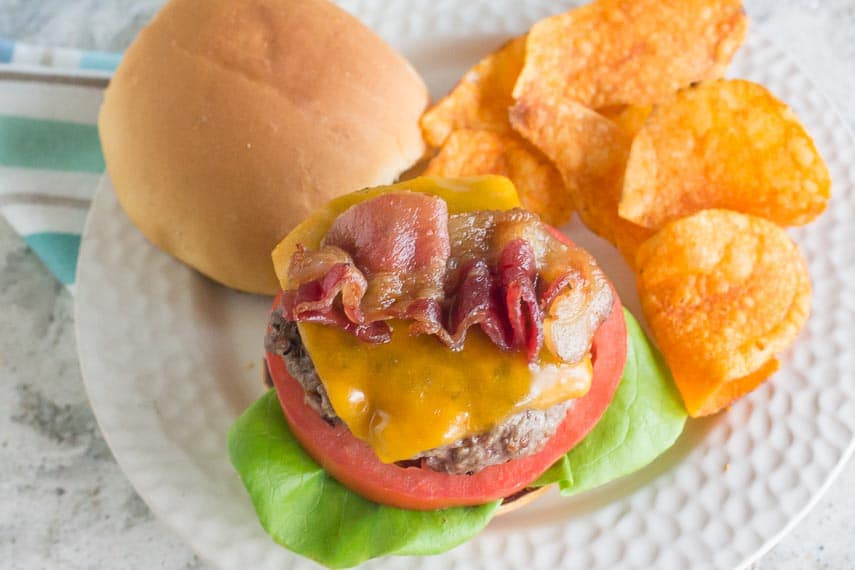
Is Cheese Low FODMAP?
This is a question we hear a lot and we understand the confusion! Be sure to read our blog article for a more in-depth discussion on Dairy Versus Lactose Free.
We also have an article titled, Is Cheese Low FODMAP? that goes into more detail.
Simply put, many hard cheeses such as cheddar cheese and Swiss are low enough in lactose to be considered low FODMAP. And they happen to be the cheeses we love melted on burgers – so enjoy!
Add the cheese slices to the tops of the burgers about 1 minute before they are done.
BTW, the cheese is strictly optional, which is why we label this recipe as Dairy-Free, as it is really all about the beef burger itself. Your choice!
What About Burger Buns?
There are low FODMAP burger buns available. You could certainly try a sourdough bun (read more in our article How To Choose Low FODMAP Bread).
There are lab tested and certified buns, too, which are listed with an asterisk below. The other ones listed are buns that our Monash trained dietitians have recommended.
- Canyon Bakehouse Gluten Free Brioche-style Sweet Rolls
- Udi’s Gluten Free Classic Hamburger Buns
- Schär Hamburger Buns *
- Schär Gluten-free Ciabatta Rolls *
- Schär Artisan Style Sandwich Rolls *
- Alpicella Sourdough Rolls Brown N Serve
- Franz Hamburger Buns Gluten Free
Making The Best Low FODMAP Burgers
Place the beef in a large bowl, season lightly with salt and pepper and gently combine; do not overwork the meat.
Divide the meat into four equal plump patties, taking care not to overly compress the meat. Make a slight dimple in the center of each patty with your thumb, which will encourage even cooking. Set aside. Have your buns toasted, if desired. (If we are using a skillet, we toast them on the skillet; if we are using a grill, we toast them on the grill).
Heat a large, heavy skillet over medium-high heat or prepare your grill to a medium-high heat. Add the burgers and cook for about 3 minutes, undisturbed. Flip over and cook for about 3 minutes more for medium-rare, or a minute longer if you like them more well done. If you are adding cheese, do so during the last minute of cooking, covering if necessary to encourage the cheese to melt.
Arrange lettuce on bottom of burger bun, add a slice of tomato and place (cheese) burger on top. Crown with bacon and add your low FODMAP condiments of choice; serve immediately.
Frequently Asked Questions
Conventional ketchup has been lab tested and has low FODMAP serving sizes, even when made with high fructose corn syrup (HFCS). In fact the servings for sugar sweetened and HFCS sweetened are exactly the same.
In additon, while companies like Fody Foods make a low FODMAP ketchup, the serving size is mere grams more than conventional ketchup?
There are pickles that are low FODMAP. Read lables and steer clear of high FODMAP ingredients like garlic and onion.
You could add herbs and spices. We like a dash of Worcestershire sauce. Try prepared horseradish! A little grated carrot can add moisture, if you are using a very lean meat mixture.
Sure, but it will be different. Check out our Low FODMAP Turkey Burger recipe.
You could, but to us that makes it meatloaf. Which we love, by the way. Check out our Everyday Meatloaf.
Mayo, low FODMAP BBQ sauce, slices of avocado, slices of tomato, mustard; get creative!
Always remember that whether something is low FODMAP, and whether it will trigger IBS symptoms for you are two different questions. The pea, lentil and faba bean protein used in this mixture is tolerated by some, and not others. Eat to your own tolerances.
The main ingredient is soy protein concentrate, which can trigger IBS symtoms for many people with IBS.
AND be sure to read our article about Low FODMAP Condiments! Many condiments are low FODMAP but you need all the info and this article will get you up to speed.
We also have a fantastic Turkey Burger for you, Salmon Burger and Lamb Burger.
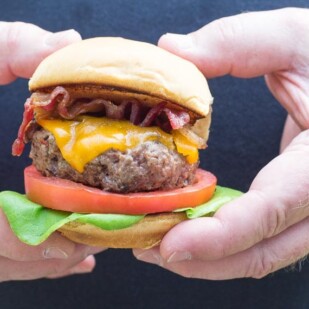
The Best Low FODMAP Burgers
This is our recipe for the best-ever low FODMAP burger!
Ingredients:
- 1 pound (455 g) 80% or 85% lean ground beef, well chilled
- Kosher salt
- Freshly ground black pepper
- 4 low FODMAP gluten-free hamburger buns
- 4 thin slices of cheddar or Swiss cheese, or your low FODMAP cheese of choice
- Lettuce, green or red leaf or butter lettuce
- 4 slices of beefsteak tomato
- 4 slices of crisp cooked bacon; use gluten-free if following a gluten-free diet
Preparation:
-
Place the beef in a mixing bowl, season lightly with salt and pepper and gently combine; do not overwork the meat.
-
Divide the meat into four equal plump patties, taking care not to overly compress the meat. Make a slight dimple in the center of each patty with your thumb, which will encourage even cooking. Set aside. Have your buns toasted, if desired. (If we are using a skillet, we toast them on the skillet; if we are using a grill, we toast them on the grill).
-
Heat a large, heavy skillet over medium-high heat or prepare your grill to a medium-high heat. Add the burgers and cook for about 3 minutes, undisturbed. Flip over and cook for about 3 minutes more for medium-rare, or a minute longer if you like them more well done. If you are adding cheese, do so during the last minute of cooking, covering if necessary to encourage the cheese to melt.
-
Arrange lettuce on bottom of burger bun, add a slice of tomato and place (cheese) burger on top. Crown with bacon and add your low FODMAP condiments of choice; serve immediately.
Dédé’s Quick Recipe Tips Video
Notes:
Tips
- One of the techniques that most home cooks perform incorrectly comes at the beginning of prep – do not over-handle or over-compact the burger. A looser pack will yield a juicer burger.
Nutrition
All nutritional information is based on third-party calculations and should be considered estimates. Actual nutritional content will vary with brands used, measuring methods, portion sizes and more. For a more detailed explanation, please read our article Understanding The Nutrition Panel Within Our Recipes.
